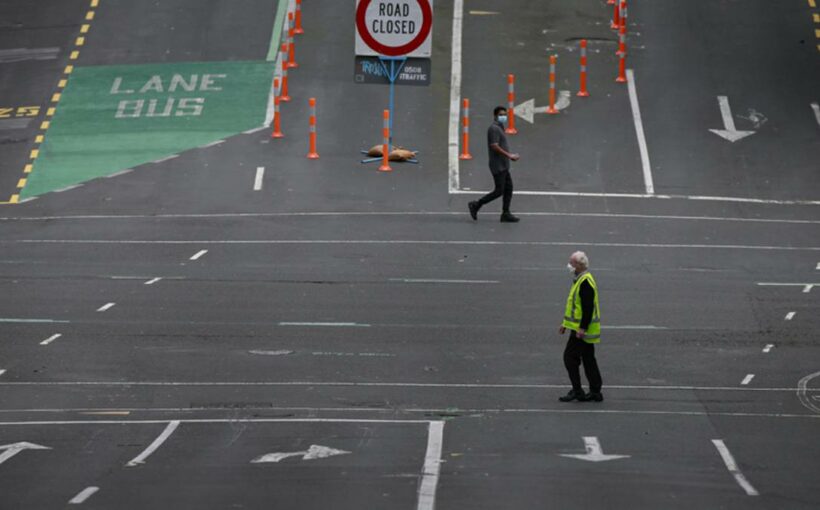The Government will face one of its toughest decisions yet when it meets on Monday to decide whether Auckland should drop to level 3 restrictions, Covid commentators say.
Health teams might not have all the answers about where and how Covid is spreading, but business and public pressure is mounting on the Government to ease lockdown restrictions.
Cabinet ministers will be forced to balance the risk of further transmission against economic pressures and concerns residents are getting “lockdown fatigue”, the experts say.
One of the key risks is whether level 3 will prove able to stamp out Covid cases.
If it doesn’t, Auckland could be forced back into level 4 at a later date or – in a worse case scenario where cases escalate like in New South Wales – be kept under tough restrictions for months until enough people are vaccinated.
Another key to Monday’s decision will be how many cases of concern are not yet linked back to people known to have the virus, and whether this means Covid is transmitting without detection.
“It’s really hard to say this time around,” University of Auckland professor in public health Dr Collin Tukuitonga said.
“The heat is on the Government from a business and economic viewpoint but at the same time we’ve still got 20 new cases today.”
University of Auckland Professor Shaun Hendy agreed.
“You could persist at level 4 and stamp this out, I’m pretty sure that would be the case,” he earlier said.
“On the other hand, everybody’s a bit over level 4, people need a bit of light at the end of the tunnel … it’s probably worth taking a calculated risk.”
It comes as there were 20 new community cases today with one of those cases not yet linked back to a person known to have the virus.
It meant that out of the outbreak’s 385 active cases, seven are yet to be epidemiologically linked.
Seven of yesterday’s 11 cases and nine of 15 cases from the day before were also infectious while in the community.
Nevertheless, director of public health Dr Caroline McElnay said there was “cautious optimism” the vast majority of the outbreak had been contained.
Despite her assurances, it remained unclear to most members of the public where recent unlinked cases have been getting the virus from.
After more than five weeks in lockdown, why are people with Covid still going out into the community while infectious?
Is it happening at supermarkets, are people venturing out when they should be isolating – the experts spoken to by the Herald said it wasn’t clear from the information released.
However, health teams would know that and be passing it on to Cabinet to weigh up when making Monday’s decision, Tukuitonga said.
He agreed that made it hard for the public and others outside the Government’s inner circle to know what is happening and how great the risk is.
It would be ideal if everyone knew as much as possible about where Covid was spreading so they could take necessary precautions themselves, Tukuitonga said.
“The problem is it takes a while to make those connections in unlinked cases and sometimes a person with Covid might be interviewed three or four times,” he said.
“It’s not that straight forward and I can understand why Ashley might not want to rush into sharing that information because sometimes the data isn’t there.”
Otago University Professor Michael Baker said there was three main ways Covid could be spreading.
That was through essential workers who rightfully needed to leave home every day to work, people at home who went shopping or sought healthcare or other essential services, and those who are “detached from or bending the rules”.
It was the third group that he was potentially worried about – whether it be at alert level 4 or alert level 3 – and especially whether they were becoming more of a problem the longer lockdown continued.
“Maybe the problem isn’t actually about the alert levels, it is the extent to which they are being followed,” he said.
“It may be more about doing a much more targeted response to where we think the weakness is in the system at the moment,” he said.
University of Auckland Associate Professor Siouxsie Wiles worried that releasing too much information could lead to privacy breaches or misinformation and vilification of people and communities.
She said lockdown had been working, and the reduction in cases so far was a big achievement, but it took time to stamp out Covid’s long tail.
“When you see those numbers coming in it can be depressing. What we don’t want is to give up because we can do this,” she said.
“Twenty cases a day is not what we want to see, but equally it is not 1300 cases a day, which is what New South Wales is experiencing.”
She said the challenge will be to see how alert level 3 coped with stopping the spread of the more infectious Delta variant.
Hendy, meanwhile, said while he was confident exiting lockdown wouldn’t be immediately catastrophic, relaxing restrictions with the virus circulated in the community could have consequences.
“If we’re still seeing consistent community transmission then by going to [level] 3, you just give [transmission] the opportunity to speed up.
“If you’re accepting that we may need to go back to level 4 in some time in October, then shifting to level 3 is a low-risk option.”
Source: Read Full Article

/cloudfront-ap-southeast-2.images.arcpublishing.com/nzme/YQWQJVBWFR4YZCCXQLTXET4R3U.jpg)
/cloudfront-ap-southeast-2.images.arcpublishing.com/nzme/GMGKIGW7VPHGEVSKGA2PBBLPRY.jpg)
/cloudfront-ap-southeast-2.images.arcpublishing.com/nzme/QV53P5RJYFW6UL7NI4C575VHHY.jpg)
/cloudfront-ap-southeast-2.images.arcpublishing.com/nzme/MCYGHZLW3FLEWNIDMDJ7DZAN44.jpg)